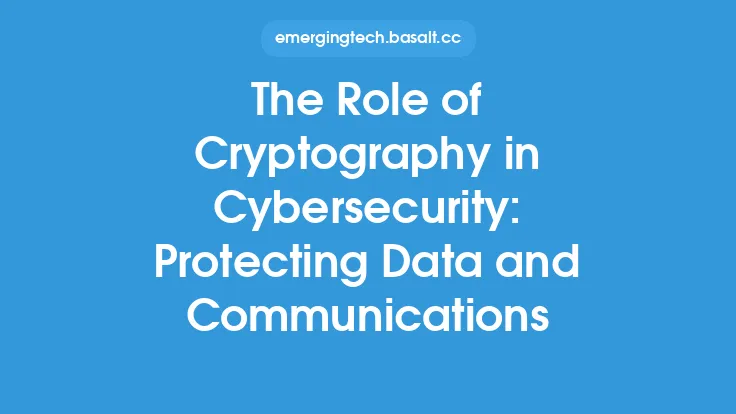The increasing reliance on digital communication and the growing threat of cyberattacks have made cybersecurity a pressing concern for individuals, organizations, and governments alike. As the field of quantum computing continues to advance, it is essential to explore the role of quantum cryptography in enhancing cybersecurity. Quantum cryptography, which utilizes the principles of quantum mechanics to secure communication, has the potential to revolutionize the way we protect sensitive information. In this article, we will delve into the threats and opportunities presented by quantum cryptography in the context of cybersecurity.
Introduction to Quantum Cryptography
Quantum cryptography is a method of secure communication that uses quantum mechanics to encode and decode messages. This approach is based on the principles of quantum entanglement, superposition, and measurement, which enable the creation of unbreakable encryption keys. Quantum cryptography is often used in conjunction with classical cryptography to provide an additional layer of security. The most well-known application of quantum cryptography is quantum key distribution (QKD), which allows two parties to securely exchange cryptographic keys over an insecure channel.
Threats to Classical Cryptography
Classical cryptography, which relies on mathematical algorithms to secure communication, is facing significant threats from the advent of quantum computing. Quantum computers have the potential to break many classical encryption algorithms, such as RSA and elliptic curve cryptography, using algorithms like Shor's algorithm. This means that sensitive information encrypted with these algorithms could be compromised, posing a significant risk to cybersecurity. Furthermore, the increasing computational power of classical computers also poses a threat to classical cryptography, as it enables attackers to perform brute-force attacks on encrypted data.
Opportunities for Quantum Cryptography
Quantum cryptography offers several opportunities for enhancing cybersecurity. Firstly, QKD provides a secure method for exchanging cryptographic keys, which can be used to encrypt and decrypt sensitive information. This approach is particularly useful for high-stakes communication, such as financial transactions and military communications. Secondly, quantum cryptography can be used to create secure communication networks, such as quantum-secured virtual private networks (VPNs). These networks can provide an additional layer of security for sensitive communication, making it more difficult for attackers to intercept and eavesdrop on sensitive information.
Quantum Cryptography Protocols
Several quantum cryptography protocols have been developed to provide secure communication. These protocols include BB84, B92, and Ekert91, among others. Each protocol has its own strengths and weaknesses, and the choice of protocol depends on the specific application and requirements. For example, the BB84 protocol is widely used for QKD, while the B92 protocol is more suitable for quantum-secured communication over long distances. Understanding the different protocols and their applications is essential for implementing quantum cryptography in practice.
Implementation and Deployment
Implementing and deploying quantum cryptography requires significant expertise and resources. Quantum cryptography systems require specialized hardware, such as quantum key generators and quantum receivers, which can be expensive and difficult to maintain. Furthermore, the deployment of quantum cryptography systems requires careful consideration of the underlying infrastructure, including the communication channel and the network architecture. Despite these challenges, several organizations and governments have already begun to deploy quantum cryptography systems, such as the SwissQuantum network in Switzerland and the Quantum Experiments at Space Scale (QUESS) satellite in China.
Security Analysis
The security of quantum cryptography systems is based on the principles of quantum mechanics, which provide a high level of security against eavesdropping and interception. However, quantum cryptography systems are not foolproof, and several security risks and challenges need to be addressed. For example, side-channel attacks, which exploit information about the implementation of the quantum cryptography system, can compromise the security of the system. Additionally, the security of quantum cryptography systems relies on the quality of the quantum keys, which can be affected by factors such as noise and interference.
Future Directions
The future of quantum cryptography is promising, with several potential applications and developments on the horizon. One area of research is the development of more efficient and practical quantum cryptography protocols, such as high-speed QKD and quantum-secured communication over long distances. Another area of research is the integration of quantum cryptography with classical cryptography, which can provide a hybrid approach to secure communication. Furthermore, the development of quantum-resistant cryptography, which can resist attacks from quantum computers, is an active area of research.
Conclusion
Quantum cryptography has the potential to revolutionize the field of cybersecurity by providing a secure method for exchanging cryptographic keys and creating secure communication networks. While there are several opportunities for quantum cryptography, there are also significant challenges and threats that need to be addressed. As the field of quantum computing continues to advance, it is essential to explore the role of quantum cryptography in enhancing cybersecurity and to develop more efficient and practical quantum cryptography protocols. By understanding the principles and applications of quantum cryptography, we can better prepare for the future of cybersecurity and develop more secure communication systems.





